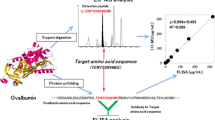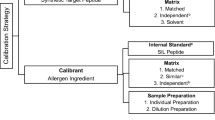Abstract
Enzymatic hydrolysis of hen egg confers beneficial functionalities, but it is essential to control the progress of hydrolysis to enhance the quality and reduce allergy risk. However, a reliable method for directly controlling the progress of egg protein hydrolysis is unavailable. Focusing on ovalbumin, a major protein and allergen in egg white, we demonstrated the applicability of liquid chromatography–tandem mass spectrometry (LC–MS/MS) to assess the degradation of ovalbumin in its enzymatic hydrolysates. Using immobilized Alcalase or Everlase, the degradation degree (DD) of ovalbumin was determined using LC–MS/MS; the result (8.8–95.3%) was highly correlated with the DD (8.9–92.3%) obtained using size-exclusion chromatography (SEC-HPLC) (r > 0.96, p < 0.001). In egg white hydrolysates with a DD of 16.1–99.5%, ovalbumin recovery when spiked with 1250 ng/mL was 81.1–114.8% with excellent dilution linearity (r2 > 0.99). These results indicate that LC–MS/MS is a reliable method for increasing the quality of enzymatically hydrolyzed egg products for food, nutraceutical, pharmaceutical, and cosmetic industries.



Similar content being viewed by others
Data availability
Not applicable.
References
Y. Zhu, S.K. Vanga, J. Wang, V. Raghavan, Impact of food processing on the structural and allergenic properties of egg white. Trends Food Sci. Technol. 78, 188–196 (2018). https://doi.org/10.1016/j.tifs.2018.06.005
B. Gazme, K. Rezaei, C.C. Udenigwe, Epitope mapping and the effects of various factors on the immunoreactivity of main allergens in egg white. Food Funct. 13, 38–51 (2022). https://doi.org/10.1039/d1fo01867a
M. Ebisawa, K. Ito, T. Fujisawa, Japanese guidelines for food allergy 2020. Allergol. Int. 69, 370–386 (2020). https://doi.org/10.1016/j.alit.2020.03.004
D. Lozano-Ojalvo, L. Pérez-Rodríguez, A. Pablos-Tanarro, E. Molina, R. López-Fandiño, Hydrolysed ovalbumin offers more effective preventive and therapeutic protection against egg allergy than the intact protein. Clin. Exp. Allergy 47, 1342–1354 (2017). https://doi.org/10.1111/cea.12989
A. Yamada, T. Hasegawa, M. Fujieda, H. Morita, K. Matsumoto, Protease-digested egg-white products induce oral tolerance in mice but elicit little IgE production upon epicutaneous exposure. Allergol. Int. (2022). https://doi.org/10.1016/j.alit.2022.03.006
M. Garcés-Rimón, M. Sandoval, E. Molina, R. López-Fandiño, M. Miguel, Egg protein hydrolysates: new culinary textures. Int. J. Gastron. Food Sci. 3, 17–22 (2016). https://doi.org/10.1016/j.ijgfs.2015.04.001
M.I. López-Martínez, S. Moreno-Fernández, M. Miguel, Development of functional ice cream with egg white hydrolysates. Int. J. Gastron. Food Sci. 25, 100334 (2021). https://doi.org/10.1016/j.ijgfs.2021.100334
S. Jalili-Firoozinezhad, M. Filippi, F. Mohabatpour, D. Letourneur, A. Scherberich, Chicken egg white: hatching of a new old biomaterial. Mater. Today (2020). https://doi.org/10.1016/j.mattod.2020.05.022
G. Lesnierowski, J. Stangierski, What’s new in chicken egg research and technology for human health promotion? A review. Trends Food Sci. Technol. 71, 46–51 (2018). https://doi.org/10.1016/j.tifs.2017.10.022
J. Adler-Nissen, Determination of the degree of hydrolysis of food protein hydrolysates by trinitrobenzenesulfonic acid. J. Agric. Food Chem. 27, 1256–1262 (1979). https://doi.org/10.1021/jf60226a042
S.M. Rutherfurd, Methodology for determining degree of hydrolysis of proteins in hydrolysates: a review. J. AOAC Int. 93, 1515–1522 (2010). https://doi.org/10.1093/jaoac/93.5.1515
T. Cucu, C. Platteau, I. Taverniers, B. Devreese, M. De Loose, B. De Meulenaer, Effect of partial hydrolysis on the hazelnut and soybean protein detectability by ELISA. Food Control 30, 497–503 (2013). https://doi.org/10.1016/j.foodcont.2012.07.017
K. Kiyota, M. Yoshimitsu, K. Uchida, K. Kajimura, Development of a liquid chromatography-tandem mass spectrometry method for simultaneous quantification of hen’s egg white allergens Gal d 1–4 in fresh and processed eggs. Food Chem. 345, 128022 (2021). https://doi.org/10.1016/j.foodchem.2020.128022
K. Ou, Y. Liu, L. Zhang, X. Yang, Z. Huang, M.R. Nout, J. Liang, Effect of neutrase, alcalase, and papain hydrolysis of whey protein concentrates on iron uptake by Caco-2 cells. J. Agric. Food Chem. 58, 4894–4900 (2010). https://doi.org/10.1021/jf100055y
S. Jakovetić, N. Luković, B. Jugović, M. Gvozdenović, S. Grbavčić, J. Jovanović, Z. Knežević-Jugović, Production of antioxidant egg white hydrolysates in a continuous stirred tank enzyme reactor coupled with membrane separation unit. Food Bioprocess. Technol. 8, 287–300 (2015). https://doi.org/10.1007/s11947-014-1402-y
A. Yang, C. Long, J. Xia, P. Tong, Y. Cheng, Y. Wang, H. Chen, Enzymatic characterisation of the immobilised Alcalase to hydrolyse egg white protein for potential allergenicity reduction. J. Sci. Food Agric. 97, 199–206 (2017). https://doi.org/10.1002/jsfa.7712
K.-H. Maurer, Detergent proteases. Curr. Opin. Biotechnol. 15, 330–334 (2004). https://doi.org/10.1016/j.copbio.2004.06.005
R. Abeynayake, S. Zhang, W. Yang, L. Chen, Development of antioxidant peptides from brewers’ spent grain proteins. LWT. 158, 113162 (2022). https://doi.org/10.1016/j.lwt.2022.113162
Y. Lu, Y.L. Wang, S.H. Gao, G.K. Wang, C.L. Yan, D.J. Chen, Interaction of quercetin with ovalbumin: spectroscopic and molecular modeling studies. J. Lumin. 129, 1048–1054 (2009). https://doi.org/10.1016/j.jlumin.2009.04.030
M. Bourin, J. Gautron, M. Berges, S. Attucci, G. Le Blay, V. Labas, Y. Nys, S. Rehault-Godbert, Antimicrobial potential of egg yolk ovoinhibitor, a multidomain Kazal-like inhibitor of chicken egg. J. Agric. Food Chem. 59, 12368–12374 (2011). https://doi.org/10.1021/jf203339t
Y. Yao, T. Liu, N. Wu, Y. Tu, X. Huang, D.U. Ahn, An efficient, scalable and environmentally friendly separation method for ovoinhibitor from chicken egg white. LWT. 127, 109367 (2020). https://doi.org/10.1016/j.lwt.2020.109367
B. Purschke, P. Meinlschmidt, C. Horn, O. Rieder, H. Jäger, Improvement of techno-functional properties of edible insect protein from migratory locust by enzymatic hydrolysis. Eur. Food Res. Technol. 244, 999–1013 (2018). https://doi.org/10.1007/s00217-017-3017-9
S.R. Shahosseini, S.R. Javadian, R. Safari, Effects of molecular weights—assisted enzymatic hydrolysis on antioxidant and anticancer activities of Liza abu muscle protein hydrolysates. Int. J. Pept. Res. Ther. 28, 72 (2022). https://doi.org/10.1007/s10989-022-10371-8
K. Eakkanaluksamee, J. Anuntagool, Optimization of high-protein glutinous rice flour production using response surface method. Rice Sci. 27, 75–80 (2020). https://doi.org/10.1016/j.rsci.2019.12.008
X. Liang, G. Qian, J. Sun et al., Evaluation of antigenicity and nutritional properties of enzymatically hydrolyzed cow milk. Sci. Rep. 11, 18623 (2021). https://doi.org/10.1038/s41598-021-98136-z
Acknowledgements
The authors thank Mr. Kotaro Uchida, Dr. Keiji Kajimura, and Dr. Kazuhiko Akutsu for their sincere encouragement.
Funding
This work was supported by the Japan Society for the Promotion of Science KAKENHI [Grant number 18K13044].
Author information
Authors and Affiliations
Contributions
KK: Conceptualization, Methodology, Validation, Formal analysis and investigation, Resources, Writing—original draft preparation, Funding acquisition. MY: Conceptualization, Resources, Writing—review and editing, Supervision. HM: Visualization, Writing—review and editing.
Corresponding author
Ethics declarations
Competing interest
The authors declare that they have no competing interest.
Informed consent
Not applicable.
Additional information
Publisher's Note
Springer Nature remains neutral with regard to jurisdictional claims in published maps and institutional affiliations.
Rights and permissions
Springer Nature or its licensor holds exclusive rights to this article under a publishing agreement with the author(s) or other rightsholder(s); author self-archiving of the accepted manuscript version of this article is solely governed by the terms of such publishing agreement and applicable law.
About this article
Cite this article
Kiyota, K., Yoshimitsu, M. & Matsui, H. Determination of degradation degree of ovalbumin in hen’s egg enzymatic hydrolysates using liquid chromatography–tandem mass spectrometry. Food Measure 17, 46–53 (2023). https://doi.org/10.1007/s11694-022-01591-z
Received:
Accepted:
Published:
Issue Date:
DOI: https://doi.org/10.1007/s11694-022-01591-z




